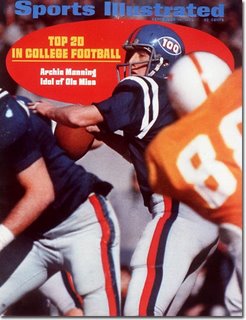The "M's" had it
While Minnesota, Mississippi, Missouri, and Michigan State have roamed the gridiron desert roughly forty years, rarely even reaching the top 25, each of these were powerhouses through the Sizzling Sixties.
Take Minnesota, for instance. The school that spawned the likes of Bronko Nagurski and Bud Grant hasn’t cracked the top ten in over 40 seasons, and only finished in the AP’s top 25 twice. But it wasn’t always that way. Two consecutive top 20 UPI (coaches poll) finishes in the late 60’s was a disappointment for fans used to winning really big.
Minnesota's prominence stretches back to the beginning of the modern day polls. The Golden Gophers took the AP’s first mythical national title in 1936, then followed up with trophies in 1940 and '41. They next garnered the first national championship of the Sixties decade as well behind the multiple skills of Sandy Stephens, making the school's fourth in the first quarter century of the AP poll--more than any other program in the nation.

The historied institution then put an exclamation point on that with two more consecutive top ten finishes in 1961 and ’62 behind the brutal force of Bobby Bell and Carl Eller, both future NFL Hall of Famers.
Many consider Ole Miss to be a bottom-feeder for the frenzied Southeastern Conference members, but the roles were reversed in the 1950’s and 60's under the leadership of legendary Johnny Vaught. Their power culminated behind the exhilarating two-way talents of Archie (“Daddy”) Manning to close the Sixties.

The Rebels haven’t won a SEC title since 1963, amazingly, though Archie led them to a top ten finish in ’69. He was a true giant killer, leading triumphs over LSU, Tennessee (38-0), and Arkansas, three squads which lost a combined one other regular season game (that being by one point to top-ranked Texas).
But Ole Miss was the giant before that. From 1952 through 1963, the Rebs lived in the top ten almost every fall, including three finishes in the nation’s top three and a national title awarded by the Football Writers (FWAA) in 1960. From 1954 to '63, Mississippi won five SEC titles. Johnny Vaught was synonymous with dominance.
"When he walks out on the field, there is a presence there that was different than any of the other coaches," said Ole Miss athletic director Pete Boone, who played for Vaught. "I remember the very first day he called my name, when I was a sophomore. ... I couldn't think of the next play, it was such a thrill for me to have a person with that kind of stature know who I was."
The Missouri Tigers possessed quite a presence when they appeared as well. Though being shut out of the top ten or even one conference championship since 1969, they roared through the Sixties, with four top ten finishes and another a wink outside of it. The decade culminated with a brutal beating of longtime rival and defending Big 8 champion Kansas, 69-21, at Lawrence. Coach Dan Devine—who was just that for the program—also led blowouts that season over Oklahoma and Michigan in Ann Arbor, while handling Nebraska as well.
 Duffy Daugherty started hinting at legendary status by the close of the 1966 season. Though Michigan State has managed no better than two two-loss seasons over the last forty tries, the Spartans came within one point of claiming their second consecutive national championship that autumn. With the likes of future NFL greats such as Bubba Smith and George Webster, MSU rolled to a 19-1-1 mark in ‘65-’66, only losing by two points in the Rose Bowl to a UCLA team it had already beaten earlier in the ’65 season. [The tie came in the infamous "Tie One For The Gipper" (video) game against eventual champ Notre Dame.]
Duffy Daugherty started hinting at legendary status by the close of the 1966 season. Though Michigan State has managed no better than two two-loss seasons over the last forty tries, the Spartans came within one point of claiming their second consecutive national championship that autumn. With the likes of future NFL greats such as Bubba Smith and George Webster, MSU rolled to a 19-1-1 mark in ‘65-’66, only losing by two points in the Rose Bowl to a UCLA team it had already beaten earlier in the ’65 season. [The tie came in the infamous "Tie One For The Gipper" (video) game against eventual champ Notre Dame.]From 1950 to 1966, the Spartans won UPI national championships in 1952 and ’65 and finished in the AP top ten eleven times, including second place four times.
A chasm between the successes of the Boomer era and the last decades defies logic in large part. Speculating on what has created the canyon intrigues those fans who love figuring the why’s of the sports world.
Regardless, the accomplishments of these programs and those individuals who coached and played for them should stand tall throughout. Their reality can’t be erased by time.

0 Comments:
Post a Comment
Subscribe to Post Comments [Atom]
<< Home